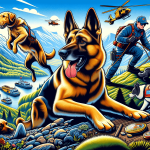It is a widely known fact that pet animals bring happiness and joy in our lives, in a way that nothing else in the world can. Of course, having friends and family around is great, but animals can satisfy humans in a way that is hard to comprehend.
Being a pet parent cannot only help an individual stay fit, but it can help in catering to their need for a constant companion. When talking about animals for companionship, dogs are hands down the best option!
Having these furry puppies run around the house is the best feeling ever. It can help people fight depression, lower their stress levels, and even keep them healthy.
Dogs are the most popular pet animals in the world. However, many people wish to adopt a pet dog, but the fear of house soiling makes them reluctant. Even though the dogs can be house trained to go potty at a fixed spot, but the whole idea sounds very daunting.
Potty Training a Puppy
The concept of potty training might seem like a bumpy ride with a lot of rug scrubbing and spraying. In reality, potty training a pet is not that difficult. Patience and consistency are the key elements of house training a puppy. Some dogs can get trained in a shorter time, will some dogs may take much longer.
Here is a complete guide that can help pet parents can potty train their puppies and have an exciting time together, free from “poopy-accidents.”
Step 1: Observing and Analyzing
The first step to potty train a dog is to observe the behavior and the needs. You need to know the number of times your dog has to release in one day and for how long they can control. It is vital to understand that all dogs, irrespective of their size, age, or breed, have a weak bladder.
Some dogs might want to go potty immediately after they eat, play, or wake up from a nap while some dogs may only need to go when they eat. It is crucial that you know exactly how many times a dog wants to release and the time between two consecutive releases to develop a potty routine.
Step 2: Set Specific Commands
The next step is to set commands. It is an essential part of the process. Whenever a dog owner catches their fur-balls in action, they need to set a command which can startle their dogs. It will help the dogs realize that it is something their owner does not like, and they will refrain from it. Word commands such as “No” and “Stop” can help the dog owners. Actions such as loud claps can even help the dog get the signal.
Step 3: Choose Type of Training
After you have set commands, you must choose the training type. There are two types of training techniques the dog owners can use, including crate training and paper training. Dogs are cleanliness-loving animals, and they cannot stand the unpleasant odor of their release in a place where they live.
Confining a dog in their crates is a great way to train them to potty outside or at a fixed spot. It is best to choose a location that is outside the house. Setting some trigger words such as “Go” or “Potty” when dog owners take their dogs to the potty spot is very helpful. Puppy pad or paper training is a smart option for those dog owners who cannot stay at home and take their dogs out for potty.
Step 4: Always Praise
A lot of pet parents scold their dogs when they soil the rugs and ruin the floor of the house. It is essential to understand that scolding and being harsh to dogs will only make them sad. It will not stop them from having accidents.
Instead of scolding the puppies, you need to praise them for doing the right thing when they go out for potty. Quietly clean the spot of the accident but praise them and offer treats whenever they release themselves at the right spot.
By following the potty train guide, you can reduce the number of “accidents” around the house and free yourself from the stress! It may take a little longer, but once it’s done, the result is fantastic!














